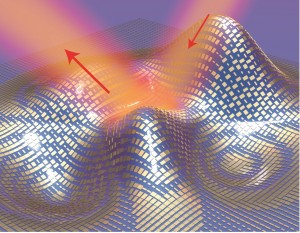
[Image above] A 3D illustration of a metasurface skin cloak made from an ultrathin layer of nanoantennas (gold blocks) covering an arbitrarily shaped object. Light reflects off the cloak (red arrows) as if it were reflecting off a flat mirror. Credit: U.C. Berkeley Lab
Harry Potter fans: get ready for this…
The concept of the invisibility cloak is no longer limited to the pages of J.K. Rowling’s fictional masterpieces. Scientists are developing this technology for real-world applications. And the new technology at work might even be scalable.
A recent study published in the journal Science outlines how scientists from the University of California, Berkeley have created what they are calling an “ultrathin invisibility skin cloak for visible light”—which has been shown to conceal irregularly shaped objects from view by guiding light around it, rendering the objects invisible in certain wavelengths of light.
A Los Angeles Times article about the study reports that “previous invisibility cloaks tried to gently redirect the light around the object they were hiding—but this required using lots of material, making the cloaks far bulkier than the object they were trying to conceal.”
“That is not practical,” study coauthor Xiang Zhang, a materials scientist at Lawrence Berkeley National Laboratory, tells the L.A. Times. “You have to carry a huge cloak around you.”
To design a much thinner, more practical invisibility cloak that can be wrapped around an object such as a sheet or skin, Zhang and his team constructed a “skin cloak” barely 80 nanometers thick and comprised of brick-like blocks of gold nanoantennas, according to a U.C. Berkeley news release.
The researchers wrapped the thin material around a “three-dimensional object about the size of a few biological cells and arbitrarily shaped with multiple bumps and dents. The surface of the skin cloak was meta-engineered to reroute reflected light waves so that the object was rendered invisible to optical detection when the cloak is activated,” according to the release.
“This is the first time a 3D object of arbitrary shape has been cloaked from visible light. Our ultra-thin cloak now looks like a coat. It is easy to design and implement, and is potentially scalable for hiding macroscopic objects,” Zhang explains in the release.
Check out a video from U.C. Berkeley of the technology in action!
Credit: Berkeley Lab; YouTube
Scaling up this technology has tremendous potential for life-changing commercial applications—from use in high-resolution optical microscopes, to security encryption purposes, and even larger-scale 3D displays.
However, Boubacar Kante, an electrical engineer at the University of California, San Diego who was not involved in the study, explains to the L.A. Times that there are some potential complications with the U.C. Berkeley study.
“The work is interesting. However, the current cloak works only for a discrete wavelength of light—730 nanometers—and would have to cover more wavelengths to be effective at a larger scale,” Kante tells the L.A. Times.
Relying on metallic particles—like the brick-like gold antennas in the U.C. Berkeley study—can also be a disadvantage, according to Kante, because they can “actually make what they’re covering seem darker than their surroundings, which can be a dead giveaway.”
So Kante is building on the invisibility cloak concept by turning to the magic of ceramics. He’s developing technology that would use a “combination of ceramic particles and teflon to achieve a similar effect.”
The U.C. Berkeley study, published in Science, is “An ultrathin invisibility skin cloak for visible light” (DOI: 10.1126/science.aac9411).
